The Mission of Visakha Sri Sarada Peetham
Epicentre of Advaita Vedanta
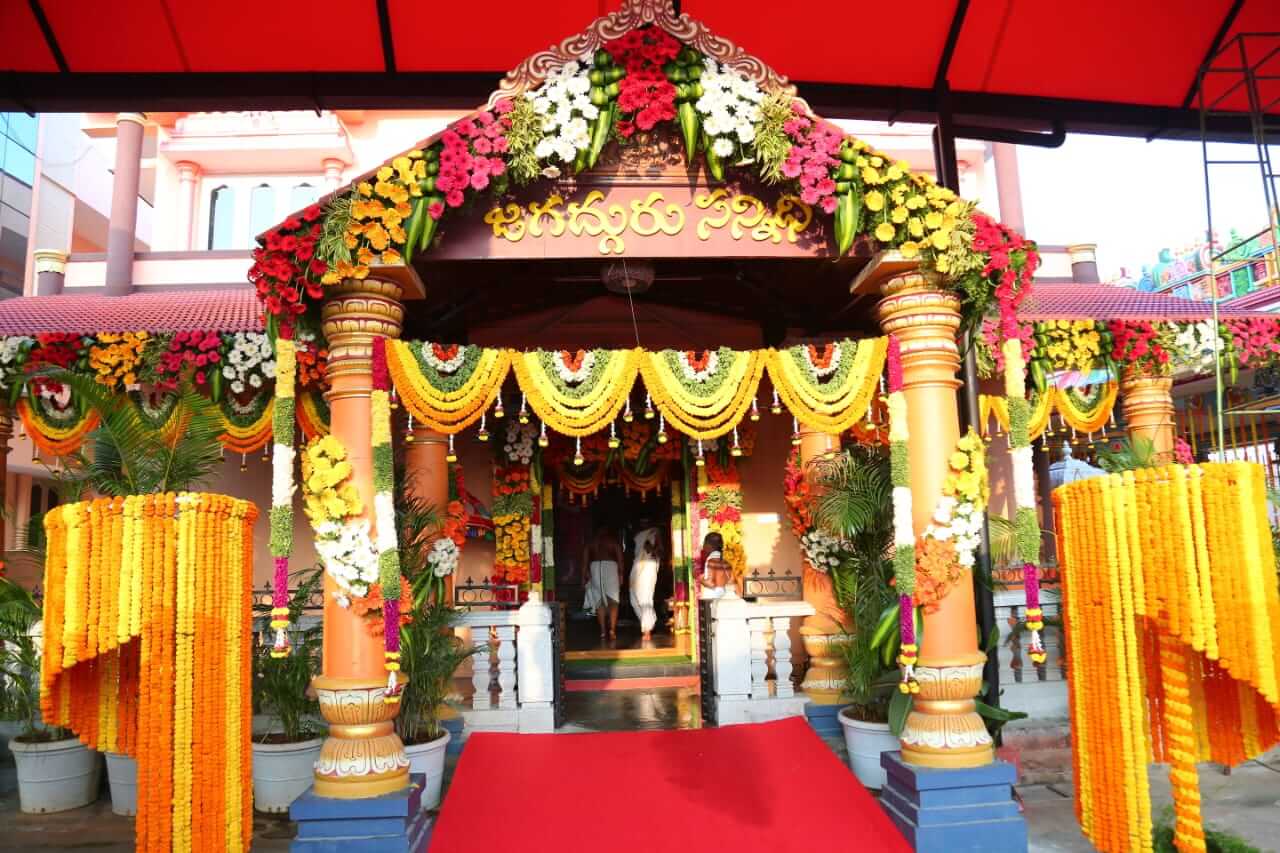
“To preserve, to disseminate and to promote Hinduism – the world’s oldest living religion, the Sanātana Dharma – across the world.”
Hinduism, considered more a ‘way of dharmic life’ than a religion, is a diverse system of thought encompassing a range of philosophies and shared concepts, rituals, cosmological systems. Hinduism is a natural religion – its philosophies & concepts, beliefs & practices, rites & rituals can be universally validated on the basis of human reason and experience, and are not revealed to a prophet by a miracle or a supernatural event.
While Hinduism is characterized by huge diversity in many schools of thought, sects, and traditions, there are certain distinctive concepts that are considered fundamental and universal – such as the oneness of existence of all living beings; and pluralism, Hinduism not only accepts a different set of theories, philosophies, and beliefs but also subsumes the very best of them.
According to Hinduism, all beings, from the tiniest organism to man, are considered the manifestations of the Supreme Being, or the Brahman Himself or the manifestations of His material energies. And the entire Universe is united and is viewed as a single family – Vasudhaiva Kutumbakam in Sanskrit. The phrase comes from the mantra VI-72 in Maha Upanishad which is an adjunct to Sāmaveda.
ayaṃ nijaḥ paro veti gaṇanā laghucetasām udāracaritānāṃ tu vasudhaiva kuṭumbakam ||
Hinduism also emphasizes equality of all mankind, as expressed in the ancient hymn, which means, “No one is superior, none inferior. All are brothers marching forward to prosperity.”
Hinduism is a truly universal religion which not only promotes the wellbeing of all living creatures but also actively works towards laying a path for all to achieve that objective. Hinduism enjoins the mankind to conduct themselves by their thoughts, words, and actions to uphold and to promote universal values such as truth, kindness, equanimity, empathy, generosity, equality and equity. The following Hindu invocation, popularly known as the Shanti Mantra, reflects this yearning for universal kinship, prosperity, and peace.
oṃ sarve bhavantu sukhinaḥ sarve santu nirāmayāḥ
sarve bhadrāṇi paśyantu mā kaścid-duḥkha-bhāgbhavet |
oṃ śāntiḥ śāntiḥ śānti ||
May all sentient beings be at peace, may no one suffer
from illness,
May all see what is auspicious [or, may all experience prosperity], may no one suffer.
Om peace, peace, peace.
Propagation of Śankara’s Advaita Vedānta- Advaita Vedānta is the premier and the oldest extant tradition of Vedānta, having been formed around the eighth century, a tradition of interpretation of the Prasthanatrayi – the Upanishads, the Brahma Sutras, and the Bhagavad Gitā and one of the six āstika (orthodox) schools of Hindu darśanam (philosophy). Advaita Vedānta is based on the concept that the higher or true Self is identical to Brahman, the Absolute Reality. The term advaita in Sanskrit, means ‘Not Two’.
What distinguishes Advaita from other forms of Vedānta is the belief that the Self or Soul (Atman) is identical to Brahman, the Supreme Soul. Knowledge of this oneness of Atman and Brahman is complete awareness. Advaita Vedanta also believes that this realization of Brahman is attainable while still living on Earth. According to Advaita metaphysics, Brahman – the ultimate, transcendent and immanent God of the latter Vedas – appears as the world because of His creative energy, māyā. The world has no separate existence apart from Brahman. The experiencing self (jīva) and the transcendental self of the Universe (ātman) are in reality identical – both are the manifestations of the same Brahman. These fundamental doctrines are represented in the anonymous verse:
brahma satyam jagan mithya. jīvo brahmaiva na aparah.
“Brahman is alone the Truth, and this world of plurality is an illusion, mithya. The individual self is not different from Brahman. Plurality is experienced because of error in judgments (mithya) and ignorance (avidya). Knowledge of Brahman removes these errors and causes liberation from the cycle of transmigration and worldly bondage.”
Śankarāchārya is the most preeminent scholar of the advaita school of Vedānta, and his commentaries on Prasthanatrayi are canonical texts of advaita thought. In Advaita Vedanta, Jnana yoga is the path of knowledge to moksha, or liberation from the cycle of life, death and rebirth. Ashtanga yoga is also a viable path in Advaita Vedanta because it helps the yogi control the senses and direct awareness inward.
The idealistic monism and the acceptance of pluralism, the cardinal principles of Advaita Vedānta, help unite the world. Sri Visakha Sarada Peetham wishes to make the world a more peaceful place by propagation of Śankara’s Advaita Vedānta.
Providing a Spiritual Direction to the Youth-
“If you want a crop for one year, grow millet; if you want a crop for ten years, grow a tree; And if you want a crop for one hundred years, grow men.”
Youth form the vital force that shapes the destiny of nations of the world. As the corporeal body of a man passes through the stages of boyhood, youth, and the old age [dehino ’smin yathā dehe kaumāraṁ yauvanaṁ jarā, Bhagavad Gita 2.13], man is the strongest – physically and mentally – during his youth. If this energy is channelized in the right direction, the youth can bring about great qualitative transformation in terms of setting the world on the right path of spiritual development and establishing lasting peace on earth. Sri Visakha Sarada Peetham acts as the beacon for the youth to guide them along the path of dharma and to mould them as the emissaries of Sanātana Dharma. The Peetham follows the dictum from Katha Upanishad, where Lord Yama advises Nachiketa thus –
uttiṣṭhata jāgrata prāpya varānnibodhata | kṣurasya dhārā niśitā duratyayā durgaṁ pathastat kavayo vadanti || [Katha Upanishad 1.3.14]
“Arise! Awake! Seek and Approach great ones and learn from them; for sharp as a razor's edge, hard to traverse, difficult to tread is that path, say the sages.”
Propagation and Dissemination of the Hindu Scriptures – the Vedās, the Upanishads, the Purānās, and the Itihāsās
Hinduism is prolific in scriptures and boasts an extensive collection of ancient religious writings. There are two historic classifications of Hindu sacred texts: Shruti – that which is heard, and Smriti – that which is remembered. The Shruti refers to the body of most authoritative, ancient religious texts, believed to be eternal knowledge authored neither by human nor divine agent but transmitted by sages (rishis). These comprise the central canon of Hinduism. It includes the four Vedas including its four types of adjunct texts – the Samhitas, the Brahmanas, the Aranyakas and the early Upanishads. Of the Vedic literature, the Upanishads are considered to be the most influential among the Hindus, considered scriptures par excellence of Hinduism, and their central ideas have continued to lend themselves to diverse philosophies and traditions.
The Smriti texts are a specific body of Hindu texts attributed to an author, as a derivative work they are considered subservient to Shruti. The Smriti literature is a vast corpus of diverse texts, and includes but is not limited to Vedāngas, the Hindu epics, the Sutras and Shastras (compilations of technical or specialized knowledge in a defined area), the texts of Hindu philosophies, the Purānās, the Kāvya or poetical literature, the Bhasyas, and numerous Nibandhas, or digests covering politics, ethics, culture, arts and society.
While the Scriptures delineate the right way to the mankind in conducting themselves in day-to-day lives, the rich heritage of Shruti and Smriti literature contains the wisdom of our ancient sages covering diverse fields of knowledge – astrology to zoology, medicine to systems of meditation, mathematics to astronomy, temple construction to town planning, engineering to aviation, just to name a few.
Visakha Sri Sarada Peetham has taken upon itself to distil this knowledge and to promote and disseminate the same for the welfare of the mankind.
Training the Preceptors
guśabdastvandhakāraḥ syāt ruśabdastannirodhakaḥ |
andhakāranirodhitvāt gururityabhidhīyate ||
[Advaya Taraka Upanishad: Verse 16]
The syllable gu means darkness, the syllable ru, he who dispels them,
Because of the power to dispel darkness, the guru is thus named.
In Hinduism Guru, or the preceptor enjoys the status equal to that of God.
In the Hindu tradition, the Guru is many things – a teacher of skills, a trainer who transmits experiential knowledge, a counsellor who instills values and ethics, an inspiration who helps guide his disciple’s spiritual development, a mentor who helps in the awakening of mind and realization of one's Self (Atma), an example to follow in the material and the spiritual life. At a socio-cultural and religious level, the Guru helps the society continue the religion and Hindu way of life.
It is the Peetham’s avowed objective to endeavour to create spiritual infrastructure for the aspiring gurus to train at the Peetham. Proliferation of such preceptors would go a long way in propagation, promotion, and dissemination of Vedic wisdom & the Hindu Way of Life.
How Visakha Sri Sarada Peetham Came into Existence
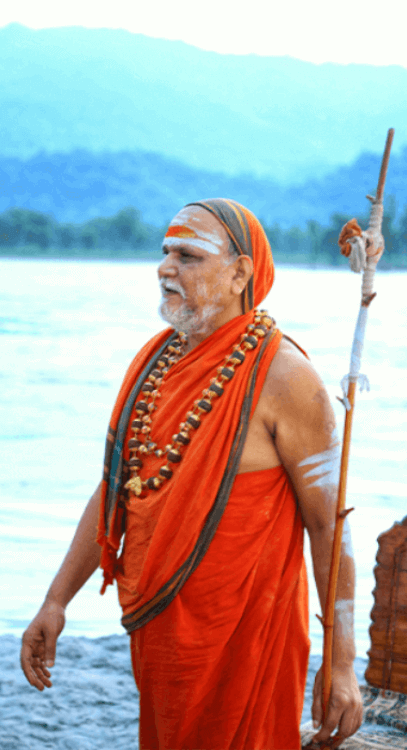
‘Dharma-samsthāpanārthāya sambhavāmi yuge yuge’, Lord Sri Krishna told Arjuna that whenever there was subversion of Dharma by the forces of adharma or evil, the lord incarnates Himself to firmly re-establish Dharma. Life and times of Sri Śankarāchārya coincide with a period of great political turmoil, and religious fragmentation. Sanātana Vaidik Dharma, or what is universally known as the Hinduism was under a severe threat not only from the other religions – mostly Buddhism, and to a lesser extent Jainism and Islam, but also from the myriad sects and splinter groups within the Hinduism, most of which were not following the Vedas & the other Scriptures. Consequently, the society started degenerating into adharma. It was time for God to descend upon earth and dispel the darkness and spread the light of dharma again. So He did! Lord Siva incarnated Himself and was born as Śankara to Aryamba and Sivaguru in a remote village in Kerala, called Kaladi. Eager to fulfil His mission on earth, young Śankara relinquished the material world at a tender age and became a sannyāsī, and became a disciple of Shri Govinda Bhagavatpadacharya – who indoctrinated young Shankara into the Advaita Vedānta.
Ādi Śankarāchārya travelled widely across the length and breadth of India, Gujarat to Bengal, and participated in public philosophical debates with different orthodox schools of Hindu philosophy, as well as heterodox traditions such as Buddhists, Jains, Arhatas, Saugatas, and Charvakas. During his tours, he is credited with starting several maṭhas, or monasteries. Ten monastic orders in different parts of India are generally attributed to Ādi Śankarāchārya’s travels, of which four pīṭhams (or peethams) have continued in His tradition: Bharati (Sringeri), Sarasvati (Kanchi), Tirtha and Asramin (Dvaraka). Other monasteries that had been established by Ādi Śankarāchārya's visit include Giri, Puri, Vana, Aranya, Parvata and Sagara – all names traceable to Ashrama system in Hinduism and Vedic literature.
Many independent pīṭhams have since been established across the country following one of the four principal pīṭhams, founded in Śankarā’s Advaita Vedanta, to promote and to propagate Sanātana Vaidik Dharma. Visakha Sri Sarada Peetham holds a distinguished position among these independent monasteries.
Ours is the only civilization still thriving among the four ancient civilizations – Mesopotamia, Egypt, the Indus Valley, and China – and is still the most relevant in these turbulent times. The Indian Way of Life, or more precisely, the Hindu Way of Life, has stood the test of time and has emerged as the most vibrant religion. It is rightly called the Sanātana, ‘the Timeless’. The Mission of Visakha Sri Sarada Peetham constitutes, promotion, and propagation of Hindu Dharma by spreading and disseminating Śankara’s Advaita Vedanta.
In the true tradition of Guru Parampara, the lineage of preeminent preceptors, Sri Sri Sri Satchidānandendra Saraswati Swamy of Holenarasipura, Hassan district, Karnataka, ordered the transport of the following spiritual and devotional inventory – received as spiritual inheritance from his Guru Parampara and dating back to circa 600 AD – to establish a Peetham dedicated to Hindu Dharma in general and to Advaita Vedanta in specific at Chinamushidivada, Visakhapatnam. This inventory included, inter alia, the ceremonial idol (Utsava Vigraha) of Goddess Sri Sarada Swaroopa Rajasyamala, a quartz Siva Linga of Sri Chandramouliswara Swamy, an emerald Siva Linga, a śālagrām (a sacred stone worshipped by the devotees and supposed to be pervaded by the presence of Lord Vishnu), Sri Narasimha Swamy idol, and Sri Chakra. Sri Swaroopanandendra Saraswati Swamy established Visakha Sri Sarada Peetham using this spiritual paraphernalia.
Within a short span, the devotional and spiritual activities have multiplied – the Peetham has become abuzz with spiritual fervour. Visakha Sri Sarada Peetham has become a lodestar for spiritual development of devotees. The Peetham has become a thriving hub of spiritual awakening, a knowledge centre of Advaita Vedanta, and a perfect retreat for meditation for the sages.
Topology of Peetham

You first encounter the welcome arch when you visit Visakha Sri Sarada Peetham at a distance of around 200m from the main entrance. The arch of the main entrance is adorned by the presiding deities of Shanmata – the Six Sects founded by Ādi Śankaracharya – namely Shiva, Vishnu, Shakti, Ganesha, Surya and Skanda. As soon as one enters the Peetham, one can experience the calm of pervading peace. The first temple one visits is that of Ādi Guru Sri Medha Dakshinamurty on the left. Various offices of the Peetham are adjacent to this temple.
Then comes the chamber named Guru Pāduka, next to which is Jagadguru Nilayam – the abode of the Pīṭhādhipati Sri Sri Sri Swaroopanandendra Saraswati Swamy and Sri Sri Sri Swatmanandendra Saraswati Swamy. Devotees get the darśan of Swamijis in the Darbar Hall here. Opposite to Darbar Hall is the Siddhi Ganapati stūpa. Swamiji worships Siddhi Ganapati first thing in the morning as soon as He completes His morning rituals.
Next to Jagadguru Nilayam is the temple dedicated to the presiding Goddess of the Peetham, Sri Sarada Swaroopa Rajashyamala. On either side of the sanctum sanctorum of the Goddess are upālayās dedicated to Vijaya Ganapati and Ādi Śankaracharya. Also within the premises is the temple of Goddess Vana Durga with Sixteen Hands. Adjacent to the temple compound is the Peetham kitchen with a dining facility. Jagadguru Śankaracharya Veda Paṭhaśala is above the kitchen.
Beyond the kitchen is the Utsava Manḍapam, opposite to which is the vividly painted stone structure presenting a scene from our Purānās – the Divine Wedding of Sri Valli and Sri Kumara Swamy. To its left is the temple of Lord Sri Krishna, and next to it is the Nāga Devata temple. Towards the north one can see the temple of Sri Dattatreya Swami. At the end of the corridor is the temple of Sri Dāsa Ānjaneya Swamy, which houses an amazing statue of Ānjaneya Swamy, 18 feet in height and made of a single śālagrāma stone. Towards the left of this temple is Swayamjyoti Manḍapam built also in śālagrāma stone. Abutting this Manḍapam is the beautiful temple of Six-faced Subrahmanyeswara Swamy with His Divine Consorts Sri Valli and Devasena.
Chandramouliswara temple is to the left of that of Sri Dāsa Ānjaneya Swamy. Also close to the temple is the beautiful sculpture of Shiva in the image of Pradosha Tānḍava Mūrti [Shiva’s Evening Cosmic Dance] and the sacred Śami tree that grants victory to the worshipper. Under the shade of this tree is the yāgaśāla built as per the principles of Āgama śāstra. In front of the yāgaśāla is the temple for daily worship dedicated to the Divine Couple – Sri Sarada Swaroopa Rajashyamala and Sri Chandramouliswara – where Swamiji worships the Ceremonial Idol of the Goddess within the Golden Temple daily. There is a beautiful garden with fragrant flowers and divine trees in front of this temple. The abode of Kāla Bhairava, the Custodian of the Peetham is in the garden.
There is a gośāla behind the Peetham. The Peetham Complex also has living quarters for the archakās and the other employees of the Peetham.
Main attributes of the Peetham:
- Maṭha Kshetram - Simhachalam
- Presiding Deity of the Peetham - Skanda
- Guardian Deity of the Peetham - Nārasimha
- Presiding Shakti of the Peetham - Sri Sarada Swaroopa Rajashyamala
- Tradition of the Peetham - Saraswati
- Teertham of the Peetham - Jnānavāpi
- Objective of the Peetham - Dissemination of Śankara’s Advaita Vedanta, & Preservation of Sanātana Dharma
Temples in the Peetham Complex
Sarada Swaroopa Rajashyamala Devi Temple
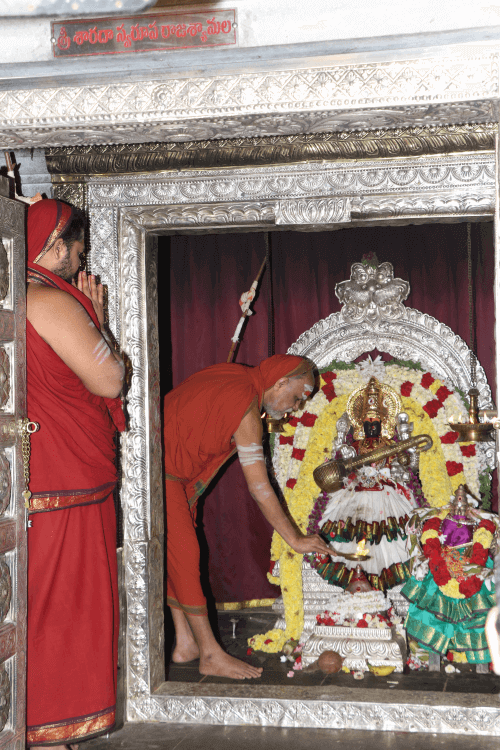
Goddess Sri Sarada Swaroopa Rajashyamala Devi is the Presiding Deity of Visakha Sri Sarada Peetham and the Śakti Swaroopini of the Peetham. The Deity is unique to Visakha Sri Sarada Peetham, in fact it is the only temple in the country dedicated to Goddess Rajashyamala Devi. According to the Scriptures, Jaganmātā* incarnated Herself as Goddess Rajashyamala – as an embodiment of mantra and tantra – to slay the demon, Bhanḍāsura. The Goddess appears as the quintessence of the three guṇās# – sattva, rajas, tamas. God, or the Immortals, worship the sattwa-image of the Goddess with four hands, the mortals worship the eight-handed, rajoguṇa-image, and the Asurās worship the tamoguṇa-image of the Goddess with sixteen hands.
There’s a reference of Shyamala Devi in Lalitopakhyāna in Brahmānda Purāna. It is presented in the form of instructions imparted to the sage Agasthya by Hayagrīva who is the incarnation of Lord Sri Maha Vishnu. In specific, the sixty-fifth name in Lalitha Sahasranamam, Bhandasura vadhodyukta-shakthi-sena-samanvita, has a direct reference to the Goddess Shyamala Devi. According to Lalitha Sahasranamam, Lalita Devi created Shyamala Devi from Her Intellect. Lalita Devi crowned Shyamala Devi as the prime minister. Hence, Shyamala Devi is also called Mantrini Devi.
Many ancient sages have written about Goddess Rajashyamala, Her Essential Nature, and the rituals of worship, in many of their treatises. Goddess Rajashyamala has been glorified as a powerful Deity in many ancient texts such as Sarada Tilakam, a the text dealing with the tantra system of worship of various deities including Ganapati, Shiva, Vishnu and various manifestations of the Goddess; Sri Ādi Śankarāchārya’s Prapanchasara Tantram; and Āmnāya Mandāram, a treatise on mantra, tantra, yantra, esoteric rituals and sādhanās. The magnificence of Goddess Rajashyamala features prominently in the worship of Dasa Mahāvidyās## as well.
Goddess Rajashyamala Devi is worshipped as the Presiding Deity of Visakha Sri Sarada Peetham. It has been a tradition with young people to dedicate their first salary to the Goddess. Rajashyamala Devi is worshipped as the Presiding Goddess of mantras & tantras in Her chariot, Geyachakra – ‘Geyachakra ratha-rudha Mantrini’. The Geyachakra Ratham is considered the symbol of victory.
The famous temple dedicated to Goddess Rajashyamala Devi in the Peetham Complex is completely built in stone – upānādi-stupi-paryantam, from the basement to the top. The temple has a tall, beautiful Rājagopuram as the entrance. The mūl virāṭṭ, or the main idol, is accompanied by the utsava mūrti of the Goddess bequeathed by Sri Sri Sri Satchidānandendra Saraswati Swamy. The Goddess is seen in a standing posture with Mount Méru at Her feet. The Mount is always covered with a silver kavacha, except on the days of full moon, during Sharan-Navaratri, and during the Peetham Anniversary celebrations. Navavarana Sri Chakra Puja is performed daily during Sharan-Navaratri days, during which devotees come in hordes to visit the temple and take darśan of Sri Chakra. Also, performing the samskāra of Aksharābhyāsam is a daily affair at the temple.
The Goddess has various other Divine Epithets such as Sukha Shyāmala, Veena Shyāmala, Śārada, and Rāja Mātangi. Goddess Rajashyamala Devi has the distinction of the Goddess who bestows political gains and positions of power to Her devotees. She was the strategist, the Mantriṇi, in the war against Bhandasura, so it is believed that Her worship results in political victories. There is many a politician who attained the highest positions of power by deep devotion to the Goddess.
[*Jaganmātā, ‘Mother of Universe’ is one of the many names of the Goddess Devī, regarded as the female principle of the Divine; the embodiment of the energies of the Gods. According to the Śivapurāṇa 2.3.25, the epithet Jaganmātā is used to describe Goddess Pārvatī. # Sattva is a state of harmony, balance, joy, and intelligence. Rajas is a state of energy, action, change, and movement. Tamas is a state of darkness, inertia, inactivity, and materiality. ## The Mahavidyas, are a group of ten Hindu Tantric goddesses manifested as forms of Divine Goddess Mahasaraswati. The ten Mahāvidyās are usually named in the following sequence: Kali, Tara, Shodashi, Bhuvaneshvari, Chhinnamasta, Bhairavi, Dhumavati, Bagalamukhi, Matangi and Kamala.]
Temples in the Peetham Complex
Sri Ādi Śankarāchārya Temple
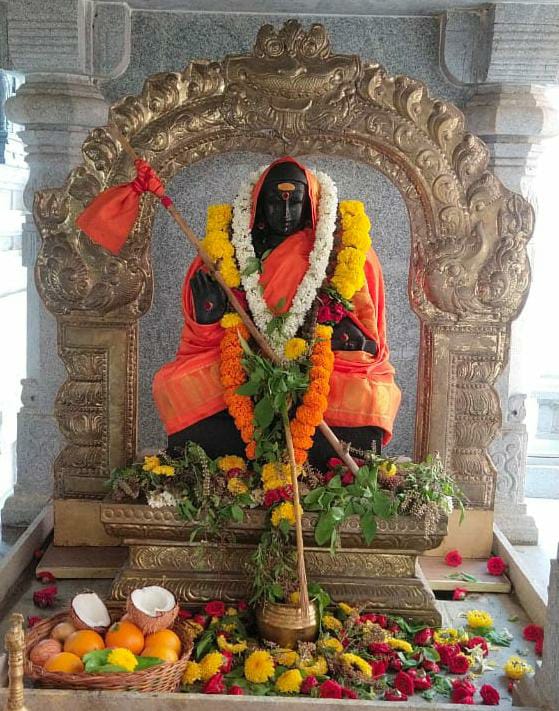
Sri Ādi Śankarāchārya alone has the distinction of the title Jagadguru, the World’s Teacher, among the Trinity of Āchāryās – Sri Madhvāchārya [Dvaita Vedanta, 13th century], Sri Ādi Śankarāchārya [Advaita Vedanta, 8th century], and Sri Rāmānujāchārya [Vishishtadvaita, 11th century].
It was Śankara’s Advaita Vedanta which firmly established that the Supreme Soul or the Ultimate Reality, known as Brahman and the human soul, Ātman, are identical and all reality is interconnected oneness. The quintessence of Śankara’s philosophy is: “Brahma satya jagat mithya, jivo Brahmaiva na aparah”. Brahman (the Absolute) alone is real; this world is unreal, an illusion created by ignorance, and the jiva or the individual soul is non-different from Brahman.
Śankara travelled across the length and breadth of India and won many theological debates and restored the Hindu Scriptures to their position of pre-eminence. He is credited with unifying the factious Hindu society divided into numerous sects and ritualistic cults, rejuvenating and strengthening Hinduism, and articulating Advaita Vedānta – a philosophy around which the entire Hindu society rallied. He reconciled the various sects of Hinduism such as the Vaishnavism, the Shaivism, and the Saktism, with the introduction of the Pañcāyatana form of worship, the simultaneous worship of five deities – Ganesha, Surya, Vishnu, Shiva and Devi, arguing that all deities were but different forms of the one Brahman, the invisible Supreme Being, implying that Advaita Vedanta overrides all other traditions.
His victories over other theologians in debates over religious philosophies helped either to drive those religions out of India or to diminish their influence greatly in India. Śankara established the primacy of Advaita Vedanta over the Āstika philosophical traditions – Sankhya, Yoga, Nyaya, Vaisheshika, Mimamsa and Vedanta; and successfully drove out Nāstika Indian philosophies include Buddhism, Jainism, Chārvāka, Ājīvika, and others.
Visakha Sri Sarada Peetham follows, promotes, and propagates Śankara’s Advaita Vedanta. Śankara Jayanti is celebrated with religious fervour every year on śukla panchami in the month of Vaisakha. Ceremonial recitation sessions of Ādi Śankarāchārya’s Commentaries are held at the Peetham, also held are the seminars & discourses on the Scriptures. Group Upanayana samskarams are also performed as part of the festivities.
Temples in the Peetham Complex
Sri Subrahmanyeswara Swami Temple
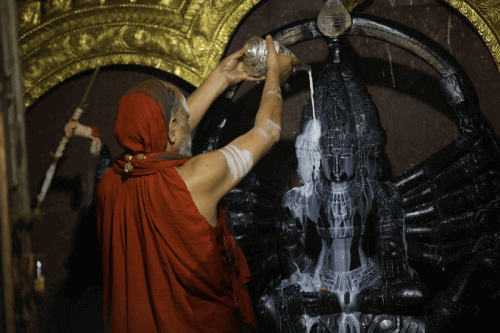
Shanmukha Sri Subrahmanyeswara Swami is the upasana daivam, Deity of Worship, of Visakha Sri Sarada Peetham. Pīṭhādhipati Sri Sri Sri Swaroopanandendra Saraswati Swamy worships Sri Subrahmanyeswara Swami daily.
Shanmukha appears flanked by consorts Valli and Devasena in the Vimāna*. The Deity can be seen in all His splendour with six faces and twelve hands gracefully seated on peacock, the mayura vāhana, flying in the direction of north.
Special archanās and abhishekams are performed on all Tuesdays, on all ṣaṣṭi tithis, and on all days of kṛtika nakshatra. The annual Chariot Festival is held every year in the twilight on the ninth day [navami] of the first fortnight [śukla pakṣa] of the lunar month Māgha. Ritual worship of Sri Subrahmanyeswara Swami is believed to result in blessings of the Lord in the form of santānam (children), vivāham (marriage), and udyogam (employment opportunities). Performing Valli Kalyānam, Divine Wedding of Sri Subrahmanyeswra Swami and Goddess Valli is known to result in an early marriage alliance for young men and women.
[* Vimāna*, the main temple tower built in Dravidian architectural style of South Indian temples as a stepped pyramid that rises up geometrically.]
Temples in the Peetham Complex
Sri Dāsa Ānjaneya Swamy Temple
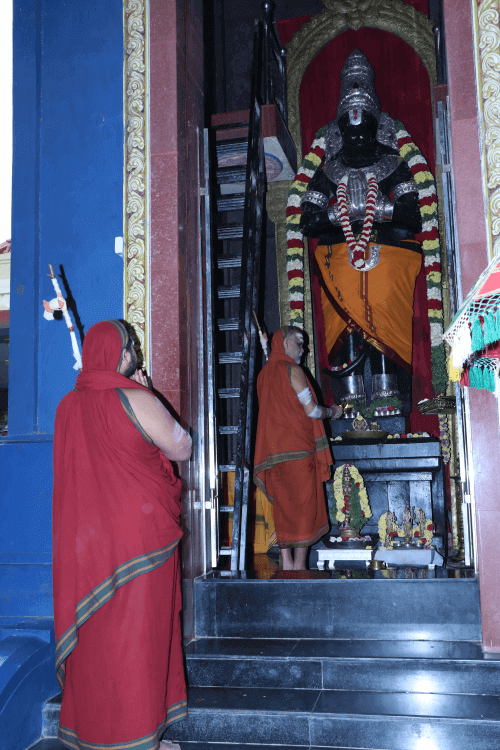
The idol of Sri Dāsa Ānjaneya Swamy in the temple is the tallest in the undivided State of Andhra Pradesh, standing at 18 ft, sculpted out of a single śālagrāma monolith. Facing south, Sri Dāsa Ānjaneya Swamy’s demeanour appears as if Swamy is ready to launch an attack on Lanka and its inhabitants. Devotees believe that their tasks are easily accomplished if one takes the darśan of Sri Dāsa Ānjaneya Swamy, and hence the temple has become famous as the Kāryasadhana Hanuman. The festival of Hanuman Jayanti is celebrated with much religious fervour; also special pujas are performed every Saturday in Purvabhadra – the birth star of Sri Ānjaneya.
Temples in the Peetham Complex
Sri Vana Durga Ālayam

It’s the firm conviction of the Pīṭhādhipati Sri Sri Sri Swaroopanandendra Saraswati Swamy that it’s the Mother Nature that is nurturing and nourishing the world. Sri Vana Durga Ālayam in the Peetham Complex bears testimony to this belief. Also, Vana is one of the many epithets of the Four-Headed Brahma, the Creator of the Universe. Therefore worshipping Vana Durga who is the alter ego of the Creator is part of the Vedic rituals. Our Scriptures prescribe that devotion to Vana Durga helps reduce or manage the effects of the climate change due to ecological imbalance. The magnificent idol of Goddess Vana Durga, having sixteen hands (ṣodaśa bhuji), is one of its kind in the two Telugu States combined. Goddess Vana Durga of Visakha Sri Sarada Peetham is believed to dispel all fears of the devotees.
Temples in the Peetham Complex
Sri Dakshināmūrti Temple
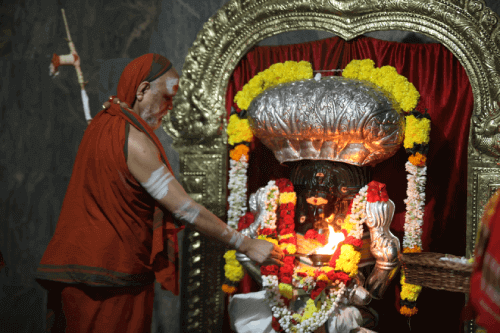
Lord Sri Dakshināmūrti is known as Ādi Guru, the Original Preceptor, of the world. He grants moksha, liberation from the eternal cycle of birth and rebirth, by mere reflection of His Name. Ādi Śankaracharya Himself professed that He worshipped Sri Dakshināmūrti. Sri Sri Sri Swaroopanandendra Saraswati Swamy dedicated a temple to worship Lord Sri Dakshināmūrti within the Peetham Complex as a means to attainment of Jnāna. The idol of Sri Dakshināmūrti installed in the temple has many distinctions. The Lord appears sitting on Mount Kailash, slaying a demon – personification of ahankāra, the ego. Four ancient sages, the Kumārās – Sanaka, Sanandana, Sanatkumāra, and Sanatsujāta – are seen sitting at Lord’s feet as His disciples. The Lord holds the sacrificial fire in one hand; ḍhamaru – a small hourglass-shaped drum – in the second, representing the cosmic sound and considered the origin of all vyākaranās; a tome in the third – a totem of all knowledge; and a chinmudra – the Gesture of Teaching on the fourth. The idol appears in a relaxed posture under the banyan tree, vata vṛkṣa, the embodiment of the universal soul.
Topology of Peetham

You first encounter the welcome arch when you visit Visakha Sri Sarada Peetham at a distance of around 200m from the main entrance. The arch of the main entrance is adorned by the presiding deities of Shanmata – the Six Sects founded by Ādi Śankaracharya – namely Shiva, Vishnu, Shakti, Ganesha, Surya and Skanda. As soon as one enters the Peetham, one can experience the calm of pervading peace. The first temple one visits is that of Ādi Guru Sri Medha Dakshinamurty on the left. Various offices of the Peetham are adjacent to this temple.
Then comes the chamber named Guru Pāduka, next to which is Jagadguru Nilayam – the abode of the Pīṭhādhipati Sri Sri Sri Swaroopanandendra Saraswati Swamy and Sri Sri Sri Swatmanandendra Saraswati Swamy. Devotees get the darśan of Swamijis in the Darbar Hall here. Opposite to Darbar Hall is the Siddhi Ganapati stūpa. Swamiji worships Siddhi Ganapati first thing in the morning as soon as He completes His morning rituals.
Next to Jagadguru Nilayam is the temple dedicated to the presiding Goddess of the Peetham, Sri Sarada Swaroopa Rajashyamala. On either side of the sanctum sanctorum of the Goddess are upālayās dedicated to Vijaya Ganapati and Ādi Śankaracharya. Also within the premises is the temple of Goddess Vana Durga with Sixteen Hands. Adjacent to the temple compound is the Peetham kitchen with a dining facility. Jagadguru Śankaracharya Veda Paṭhaśala is above the kitchen.
Beyond the kitchen is the Utsava Manḍapam, opposite to which is the vividly painted stone structure presenting a scene from our Purānās – the Divine Wedding of Sri Valli and Sri Kumara Swamy. To its left is the temple of Lord Sri Krishna, and next to it is the Nāga Devata temple. Towards the north one can see the temple of Sri Dattatreya Swami. At the end of the corridor is the temple of Sri Dāsa Ānjaneya Swamy, which houses an amazing statue of Ānjaneya Swamy, 18 feet in height and made of a single śālagrāma stone. Towards the left of this temple is Swayamjyoti Manḍapam built also in śālagrāma stone. Abutting this Manḍapam is the beautiful temple of Six-faced Subrahmanyeswara Swamy with His Divine Consorts Sri Valli and Devasena.
Chandramouliswara temple is to the left of that of Sri Dāsa Ānjaneya Swamy. Also close to the temple is the beautiful sculpture of Shiva in the image of Pradosha Tānḍava Mūrti [Shiva’s Evening Cosmic Dance] and the sacred Śami tree that grants victory to the worshipper. Under the shade of this tree is the yāgaśāla built as per the principles of Āgama śāstra. In front of the yāgaśāla is the temple for daily worship dedicated to the Divine Couple – Sri Sarada Swaroopa Rajashyamala and Sri Chandramouliswara – where Swamiji worships the Ceremonial Idol of the Goddess within the Golden Temple daily. There is a beautiful garden with fragrant flowers and divine trees in front of this temple. The abode of Kāla Bhairava, the Custodian of the Peetham is in the garden.
There is a gośāla behind the Peetham. The Peetham Complex also has living quarters for the archakās and the other employees of the Peetham.
Main attributes of the Peetham:
- Maṭha Kshetram - Simhachalam
- Presiding Deity of the Peetham - Skanda
- Guardian Deity of the Peetham - Nārasimha
- Presiding Shakti of the Peetham - Sri Sarada Swaroopa Rajashyamala
- Tradition of the Peetham - Saraswati
- Teertham of the Peetham - Jnānavāpi
- Objective of the Peetham - Dissemination of Śankara’s Advaita Vedanta, & Preservation of Sanātana Dharma
Temples in the Peetham Complex
Sarada Swaroopa Rajashyamala Devi Temple

Goddess Sri Sarada Swaroopa Rajashyamala Devi is the Presiding Deity of Visakha Sri Sarada Peetham and the Śakti Swaroopini of the Peetham. The Deity is unique to Visakha Sri Sarada Peetham, in fact it is the only temple in the country dedicated to Goddess Rajashyamala Devi. According to the Scriptures, Jaganmātā* incarnated Herself as Goddess Rajashyamala – as an embodiment of mantra and tantra – to slay the demon, Bhanḍāsura. The Goddess appears as the quintessence of the three guṇās# – sattva, rajas, tamas. God, or the Immortals, worship the sattwa-image of the Goddess with four hands, the mortals worship the eight-handed, rajoguṇa-image, and the Asurās worship the tamoguṇa-image of the Goddess with sixteen hands.
There’s a reference of Shyamala Devi in Lalitopakhyāna in Brahmānda Purāna. It is presented in the form of instructions imparted to the sage Agasthya by Hayagrīva who is the incarnation of Lord Sri Maha Vishnu. In specific, the sixty-fifth name in Lalitha Sahasranamam, Bhandasura vadhodyukta-shakthi-sena-samanvita, has a direct reference to the Goddess Shyamala Devi. According to Lalitha Sahasranamam, Lalita Devi created Shyamala Devi from Her Intellect. Lalita Devi crowned Shyamala Devi as the prime minister. Hence, Shyamala Devi is also called Mantrini Devi.
Many ancient sages have written about Goddess Rajashyamala, Her Essential Nature, and the rituals of worship, in many of their treatises. Goddess Rajashyamala has been glorified as a powerful Deity in many ancient texts such as Sarada Tilakam, a the text dealing with the tantra system of worship of various deities including Ganapati, Shiva, Vishnu and various manifestations of the Goddess; Sri Ādi Śankarāchārya’s Prapanchasara Tantram; and Āmnāya Mandāram, a treatise on mantra, tantra, yantra, esoteric rituals and sādhanās. The magnificence of Goddess Rajashyamala features prominently in the worship of Dasa Mahāvidyās## as well.
Goddess Rajashyamala Devi is worshipped as the Presiding Deity of Visakha Sri Sarada Peetham. It has been a tradition with young people to dedicate their first salary to the Goddess. Rajashyamala Devi is worshipped as the Presiding Goddess of mantras & tantras in Her chariot, Geyachakra – ‘Geyachakra ratha-rudha Mantrini’. The Geyachakra Ratham is considered the symbol of victory.
The famous temple dedicated to Goddess Rajashyamala Devi in the Peetham Complex is completely built in stone – upānādi-stupi-paryantam, from the basement to the top. The temple has a tall, beautiful Rājagopuram as the entrance. The mūl virāṭṭ, or the main idol, is accompanied by the utsava mūrti of the Goddess bequeathed by Sri Sri Sri Satchidānandendra Saraswati Swamy. The Goddess is seen in a standing posture with Mount Méru at Her feet. The Mount is always covered with a silver kavacha, except on the days of full moon, during Sharan-Navaratri, and during the Peetham Anniversary celebrations. Navavarana Sri Chakra Puja is performed daily during Sharan-Navaratri days, during which devotees come in hordes to visit the temple and take darśan of Sri Chakra. Also, performing the samskāra of Aksharābhyāsam is a daily affair at the temple.
The Goddess has various other Divine Epithets such as Sukha Shyāmala, Veena Shyāmala, Śārada, and Rāja Mātangi. Goddess Rajashyamala Devi has the distinction of the Goddess who bestows political gains and positions of power to Her devotees. She was the strategist, the Mantriṇi, in the war against Bhandasura, so it is believed that Her worship results in political victories. There is many a politician who attained the highest positions of power by deep devotion to the Goddess.
[*Jaganmātā, ‘Mother of Universe’ is one of the many names of the Goddess Devī, regarded as the female principle of the Divine; the embodiment of the energies of the Gods. According to the Śivapurāṇa 2.3.25, the epithet Jaganmātā is used to describe Goddess Pārvatī. # Sattva is a state of harmony, balance, joy, and intelligence. Rajas is a state of energy, action, change, and movement. Tamas is a state of darkness, inertia, inactivity, and materiality. ## The Mahavidyas, are a group of ten Hindu Tantric goddesses manifested as forms of Divine Goddess Mahasaraswati. The ten Mahāvidyās are usually named in the following sequence: Kali, Tara, Shodashi, Bhuvaneshvari, Chhinnamasta, Bhairavi, Dhumavati, Bagalamukhi, Matangi and Kamala.]
Ādi Śankarāchārya Temple

Sri Ādi Śankarāchārya alone has the distinction of the title Jagadguru, the World’s Teacher, among the Trinity of Āchāryās – Sri Madhvāchārya [Dvaita Vedanta, 13th century], Sri Ādi Śankarāchārya [Advaita Vedanta, 8th century], and Sri Rāmānujāchārya [Vishishtadvaita, 11th century].
It was Śankara’s Advaita Vedanta which firmly established that the Supreme Soul or the Ultimate Reality, known as Brahman and the human soul, Ātman, are identical and all reality is interconnected oneness. The quintessence of Śankara’s philosophy is: “Brahma satya jagat mithya, jivo Brahmaiva na aparah”. Brahman (the Absolute) alone is real; this world is unreal, an illusion created by ignorance, and the jiva or the individual soul is non-different from Brahman.
Śankara travelled across the length and breadth of India and won many theological debates and restored the Hindu Scriptures to their position of pre-eminence. He is credited with unifying the factious Hindu society divided into numerous sects and ritualistic cults, rejuvenating and strengthening Hinduism, and articulating Advaita Vedānta – a philosophy around which the entire Hindu society rallied. He reconciled the various sects of Hinduism such as the Vaishnavism, the Shaivism, and the Saktism, with the introduction of the Pañcāyatana form of worship, the simultaneous worship of five deities – Ganesha, Surya, Vishnu, Shiva and Devi, arguing that all deities were but different forms of the one Brahman, the invisible Supreme Being, implying that Advaita Vedanta overrides all other traditions.
His victories over other theologians in debates over religious philosophies helped either to drive those religions out of India or to diminish their influence greatly in India. Śankara established the primacy of Advaita Vedanta over the Āstika philosophical traditions – Sankhya, Yoga, Nyaya, Vaisheshika, Mimamsa and Vedanta; and successfully drove out Nāstika Indian philosophies include Buddhism, Jainism, Chārvāka, Ājīvika, and others.
Visakha Sri Sarada Peetham follows, promotes, and propagates Śankara’s Advaita Vedanta. Śankara Jayanti is celebrated with religious fervour every year on śukla panchami in the month of Vaisakha. Ceremonial recitation sessions of Ādi Śankarāchārya’s Commentaries are held at the Peetham, also held are the seminars & discourses on the Scriptures. Group Upanayana samskarams are also performed as part of the festivities.
Subrahmanyeswara Swami Temple

Shanmukha Sri Subrahmanyeswara Swami is the upasana daivam, Deity of Worship, of Visakha Sri Sarada Peetham. Pīṭhādhipati Sri Sri Sri Swaroopanandendra Saraswati Swamy worships Sri Subrahmanyeswara Swami daily.
Shanmukha appears flanked by consorts Valli and Devasena in the Vimāna*. The Deity can be seen in all His splendour with six faces and twelve hands gracefully seated on peacock, the mayura vāhana, flying in the direction of north.
Special archanās and abhishekams are performed on all Tuesdays, on all ṣaṣṭi tithis, and on all days of kṛtika nakshatra. The annual Chariot Festival is held every year in the twilight on the ninth day [navami] of the first fortnight [śukla pakṣa] of the lunar month Māgha. Ritual worship of Sri Subrahmanyeswara Swami is believed to result in blessings of the Lord in the form of santānam (children), vivāham (marriage), and udyogam (employment opportunities). Performing Valli Kalyānam, Divine Wedding of Sri Subrahmanyeswra Swami and Goddess Valli is known to result in an early marriage alliance for young men and women.
[* Vimāna*, the main temple tower built in Dravidian architectural style of South Indian temples as a stepped pyramid that rises up geometrically.]
Dāsa Ānjaneya Swamy Temple

The idol of Sri Dāsa Ānjaneya Swamy in the temple is the tallest in the undivided State of Andhra Pradesh, standing at 18 ft, sculpted out of a single śālagrāma monolith. Facing south, Sri Dāsa Ānjaneya Swamy’s demeanour appears as if Swamy is ready to launch an attack on Lanka and its inhabitants. Devotees believe that their tasks are easily accomplished if one takes the darśan of Sri Dāsa Ānjaneya Swamy, and hence the temple has become famous as the Kāryasadhana Hanuman. The festival of Hanuman Jayanti is celebrated with much religious fervour; also special pujas are performed every Saturday in Purvabhadra – the birth star of Sri Ānjaneya.
Vana Durga Ālayam

It’s the firm conviction of the Pīṭhādhipati Sri Sri Sri Swaroopanandendra Saraswati Swamy that it’s the Mother Nature that is nurturing and nourishing the world. Sri Vana Durga Ālayam in the Peetham Complex bears testimony to this belief. Also, Vana is one of the many epithets of the Four-Headed Brahma, the Creator of the Universe. Therefore worshipping Vana Durga who is the alter ego of the Creator is part of the Vedic rituals. Our Scriptures prescribe that devotion to Vana Durga helps reduce or manage the effects of the climate change due to ecological imbalance. The magnificent idol of Goddess Vana Durga, having sixteen hands (ṣodaśa bhuji), is one of its kind in the two Telugu States combined. Goddess Vana Durga of Visakha Sri Sarada Peetham is believed to dispel all fears of the devotees.
Dakshināmūrti Temple

Lord Sri Dakshināmūrti is known as Ādi Guru, the Original Preceptor, of the world. He grants moksha, liberation from the eternal cycle of birth and rebirth, by mere reflection of His Name. Ādi Śankaracharya Himself professed that He worshipped Sri Dakshināmūrti. Sri Sri Sri Swaroopanandendra Saraswati Swamy dedicated a temple to worship Lord Sri Dakshināmūrti within the Peetham Complex as a means to attainment of Jnāna. The idol of Sri Dakshināmūrti installed in the temple has many distinctions. The Lord appears sitting on Mount Kailash, slaying a demon – personification of ahankāra, the ego. Four ancient sages, the Kumārās – Sanaka, Sanandana, Sanatkumāra, and Sanatsujāta – are seen sitting at Lord’s feet as His disciples. The Lord holds the sacrificial fire in one hand; ḍhamaru – a small hourglass-shaped drum – in the second, representing the cosmic sound and considered the origin of all vyākaranās; a tome in the third – a totem of all knowledge; and a chinmudra – the Gesture of Teaching on the fourth. The idol appears in a relaxed posture under the banyan tree, vata vṛkṣa, the embodiment of the universal soul.